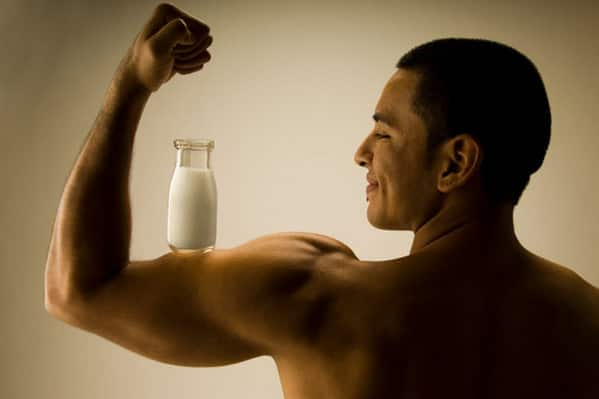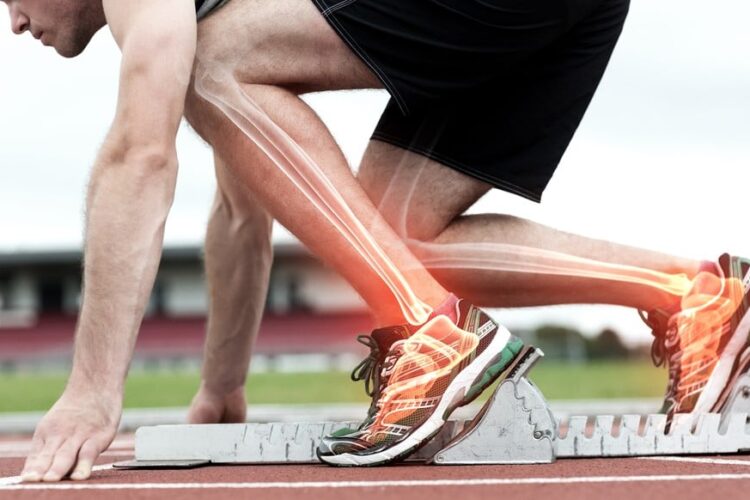Your bones are vital to your overall health and wellness.
The skeletal structure fulfills critical roles like securely fastening muscle tissue in place, shielding key organs from impact damage, and providing the framework you need to engage in physical activity.
However, bone health is often neglected, and myths about our bones abound in modern society.
Here’s a fact—Approximately 54 million Americans are suffering from low bone mass or reduced bone density right now.
In other words, a sizeable portion of American adults are enduring bone health decline, making them more susceptible to injury, deformity, and potential incapacitation.
That’s why we’re here to separate fact from fiction and debunk some common myths concerning men and bone health.
Are you ready to get the facts straight, giving yourself the upper hand in the ongoing battle against weakened, “glass-like” bones?
Let’s get into it.
Myth #1—Bone Density Loss Really Only Affects Women
Men tend to have larger skeletal structures than women. Therefore, bone density loss is more likely to affect women, especially earlier in life.
That being said, bone health issues are still a serious concern for men.
At least 20% of men will suffer a fracture due to bone density loss in their lifetime, and men are responsible for more than 25% of all bone loss-induced hip fractures.
In many cases, these injuries can be debilitating and even substantially increase one’s likelihood of mortality.
According to the American Academy of Physicians, hip fractures in men result in a 31% mortality rate after a year, whereas that number is just 17% in women.
Bone decline often happens later in life for men than women, but as much as 47% of men over age 50 experience alarming levels of bone loss.
The fact is—Bone decline occurs in women earlier and more frequently than in men, yet bone mass loss and bone density degradation are relatively common in men and often come with severe repercussions.

Myth #2—Bone Density Loss Results From Aging & Only Affects Older People
Many of us associate bone health problems with the elderly. We may believe we won’t have to worry about our bones until we’re old and grey.
However, this belief isn’t entirely rooted in facts.
Bone loss occurs when bone resorption rates are faster than bone-building rates. As a result, bone tissue becomes thinner, sponge-like, and brittle.
This can happen for several reasons outside of simply aging.
Typical risk factors for bone loss in younger men include:
- Insufficient Nutrient Intake
- Lack Of Physical Activity
- Low Testosterone Levels
- Excess Alcohol Ingestion
- Tobacco Usage
- Long-Term Stress
- Genetic Predisposition
The American Osteopathic Association reports that about 28% of men aged 35-50 experience notable bone health deterioration.
In many cases, this deterioration may not be a cause for immediate concern. However, the problem can worsen with time if nothing is done to prevent further decay.
The fact is—Bone decline does occur in younger men, though likely at lesser rates than in older men. Lifestyle choices and genetic predispositions can contribute to the early onset of bone health issues.
Myth #3—Calcium Is The Only Bone-Supporting Nutrient
Calcium receives much of the publicity when it comes to bone-supporting nutrients. We’ve all probably been told calcium is the end-all-be-all for healthy bones.
And while calcium is essential to bone health, this simply isn’t the case.
When ingested in adequate amounts, multiple vitamins, minerals, and other natural compounds benefit bone health.
Other essential bone-supporting nutrients include:
- Vitamin D
- Phosphorous
- Magnesium
- Zinc
Vitamin D is critical to promoting calcium absorption and enhancing bone mineralization rates.
Nutritional guidelines recommend healthy individuals consume 400-1,000 IU of vitamin D daily, though as much as 2,000 IU per day may be necessary for individuals at high risk of bone health issues.
Furthermore, bones are largely made up of proteins like collagen. Thus, sufficient daily protein intake is vital to stimulate healthy bone cell regeneration.
The fact is—Calcium is critical to bone health. It’s recommended most men get at least 1,000mg per day. However, several other compounds are also essential to promoting healthier bones.
Myth #4—Bone Health Can’t Be Improved By Training
You’ve probably never heard someone say their exercise goals include strengthening their bones or empowering their skeletal structure.
Yet, multiple forms of exercise can help your bones repair, rebuild, and grow stronger than ever before.
That’s because regularly applying healthy levels of stress on bones stimulates the synthesis of osteoblasts, specialized cells that form new bone tissue and repair damaged bone tissue.
The best forms of exercise for bone wellness include:
- Weight-Bearing Activities (Jogging, Hiking, Climbing)
- Resistance Training (Weight-Lifting, Bodyweight Exercises)
- High-Impact Training (Long Distance Running, Plyometrics)
For older individuals, balance and stability exercises may provide lower-impact alternatives to support bone health.
Activities such as yoga or tai chi can help men reduce the likelihood of falls, a significant source of bone injuries in older men.
The fact is—Regularly engaging in exercise or specialized training can help mitigate bone health decline. Healthy levels of stress on bones prompt greater bone health, and balance training helps older men limit the likelihood of catastrophic falls.

Myth #5—Symptoms Of Bone Density Loss Are Easy To Spot
Most people believe it’s easy to recognize the symptoms of bone density decline. Yet, many times, this isn’t actually the case.
That’s why many health professionals have deemed bone degradation as the “silent killer” for otherwise healthy men.
According to the National Institutes of Health, “you typically do not have symptoms” and may not even know there is an issue until a fracture occurs.
And as you know, severe fractures, especially in older individuals, can result in acute, long-term health issues.
All men over 50, and perhaps younger individuals with high-risk factors, should receive bone mineral density (BMD) tests.
The most common form of BMD testing is a DEXA scan involving a scaled-down X-ray test to measure bone density. Other tests, such as a blood test measuring density biomarkers, may also be available.
The fact is—Bone density decline often goes unnoticed until disaster strikes. The only way to know whether or not you’re susceptible is to get tested. DEXA scans are generally considered the “gold standard” in bone density testing, but other tests are also available.
Myth #6—Bone Loss Can’t Be Slowed Once It’s Begun
Indeed, bone loss generally accelerates for men with age, especially after 65. However, the assumption that this can’t be slowed or lessened is untrue.
We can take many actions to ensure our bones remain healthy and gain mass and density with time.
These include:
- Regularly Exercising—As previously stated, weight-bearing exercises and resistance training can stimulate enhanced bone proliferation and lessen the likelihood of fractures.
- Eating A Balanced Diet—Regularly consuming a balanced diet full of whole foods containing nutrients like vitamin D, vitamin K, calcium, and magnesium can do wonders for long-term bone health.
- Cutting Out Tobacco & Alcohol—Tobacco and alcohol both inhibit calcium absorption and harm hormonal balance, significant factors in bone degradation. Giving up these “vices” makes restoring greater bone density possible.
- Trying A Bone Density Supplement—Many health professionals recommend all-natural bone density supplements that use research-supported vitamins, minerals, and other nutrients to support bone health.
By incorporating these practices into your daily life, you can at least put a dent in declining bone density measurements.
Another key factor in success is to remain vigilant. If you know your bone mass is declining, get tested regularly to see precisely where you’re at.
The fact is—Adhering to strict daily practices such as those seen above can help you to lessen the rate of bone loss and potentially even add bone mass in time.

Myth #7—Drinking Milk Is The Best Way To Enhance Bone Health
Traditionally, milk is considered the “best” bone-promoting dietary staple. And while it is a good source of calcium, it has issues that may make it less than ideal for many.
For example, individuals with lactose intolerance won’t want to get calcium from milk.
The good news is that other, potentially better, dietary sources of bone-boosting nutrients exist.
These include:
- Fortified Plant-Based Milk or Yogurt—Dairy alternatives usually supply adequate vitamin D and calcium servings. Sugar-free options are generally best.
- Leafy Green Vegetables—Many vegetables like broccoli or spinach contain high concentrations of vitamin K and some magnesium, both beneficial for bone health.
- Legumes, Nuts, & Seeds—Foods like black beans, almonds, and chia seeds contain calcium. Plus, they have tremendous concentrations of magnesium.
Adding these foods to your regular diet can help you maintain bone health and promote gains in bone mass.
The fact is—Milk is a good source of calcium. However, it can be problematic for some individuals. Other foods, like those above, can offer comparable calcium servings to milk with the bonus of additional nutrients.
A Natural Bone Health Supplement To Support Greater Bone Quality
Regularly eating well, working out, and doing all the other things necessary to support optimal bone health isn’t easy.
However, an all-natural bone health supplement can help to enhance your bone wellness with just a serving a day.

If you’re interested in trying a 100% natural formula backed by science, we recommend looking at PrimeGENIX Bone Complex, built for superior absorbability.


